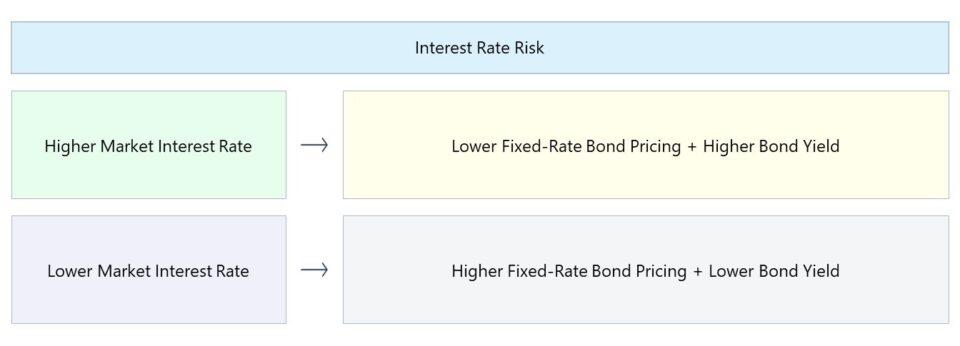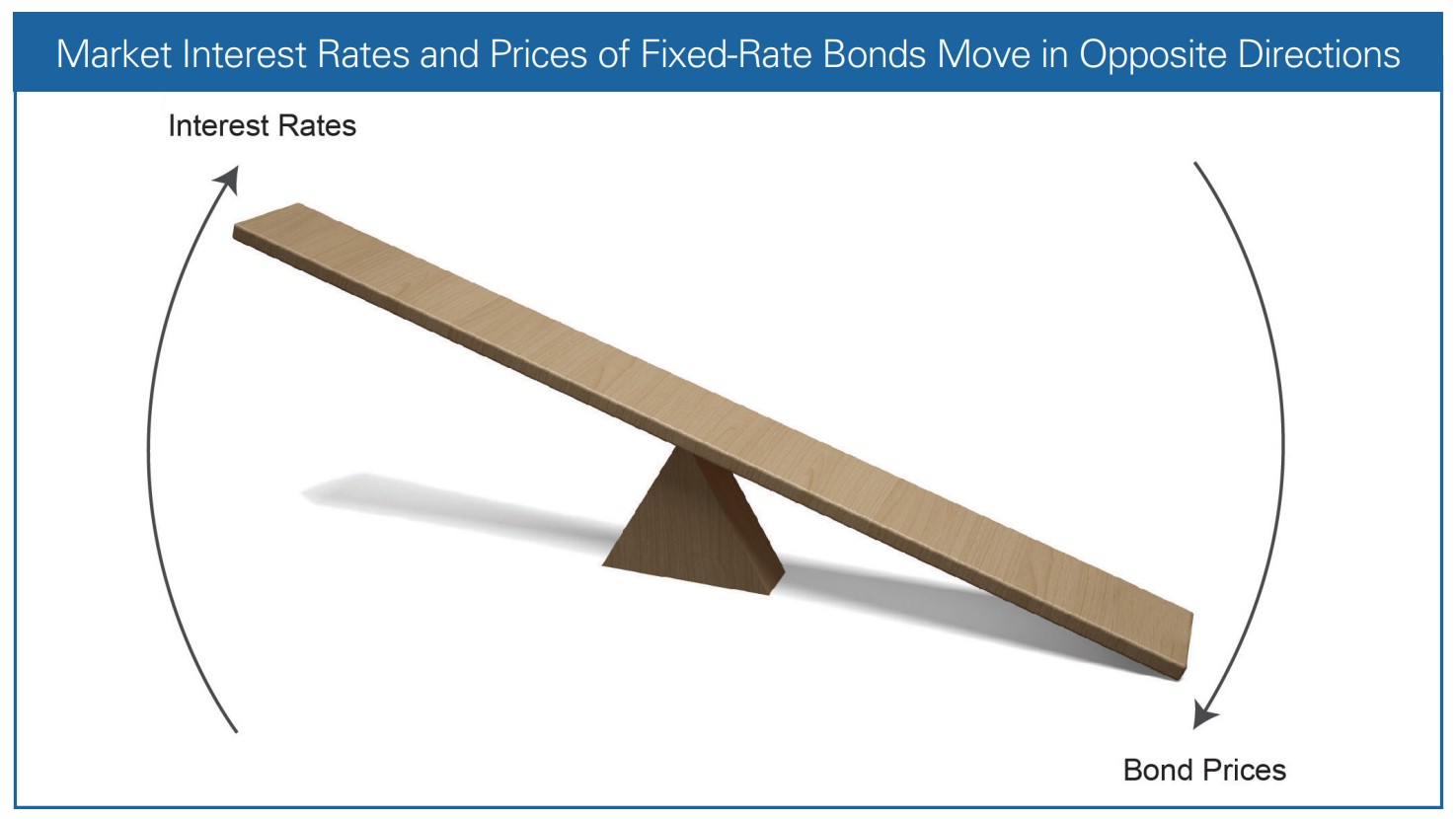- What is Interest Rate Risk?
- How Does Interest Rate Risk Work?
- How to Mitigate Interest Rate Risk
- How Does Bond Maturity Impact Interest Rate Risk?
- Market Interest Rate vs. Bond Price: What is the Relationship?
- What is an Example of Interest Rate Risk?
- Interest Rate Risk vs. Reinvestment Risk: What is the Difference?
What is Interest Rate Risk?
Interest Rate Risk represents the inherent potential for monetary losses incurred by a lender from fluctuations in the market interest rate.

How Does Interest Rate Risk Work?
Interest rate risk is an inevitable part of the lending business model for all financial intermediaries offering debt financing and interest-bearing products, particularly for fixed-income securities.
The price of a fixed-rate bond—other than the credit quality of the issuer—is determined by its maturity and coupon rate (%).
- Maturity → The specific date on which the debt principal must be repaid in full per the lending agreement.
- Coupon Rate (%) → The interest rate attached to a debt instrument, which reflects the riskiness and credit profile of the borrower (and determines the value of each interest payment).
Because the market interest rate is rather unpredictable and fluctuates constantly based on the announcement of recent news and external macro events—the underlying financial asset, such as a loan or corporate bond—is at risk of losing a portion of its original price relative to the date of issuance (% of par).
- Higher Market Interest Rates → Lower Fixed-Rate Bond Pricing
- Lower Market Interest Rates → Higher Fixed-Rate Bond Pricing
How to Mitigate Interest Rate Risk
The effect of the market interest rate on the bond pricing environment reflects the concept of interest rate risk, wherein the yield earned by lenders is subject to the current prevailing market conditions.
Therefore, lenders must ensure the proper measures are put into place to mitigate the potential for losses and de-risk their portfolio via hedging strategies.
The most fundamental method to mitigate the interest rate risk is portfolio diversification, with regard to the following factors:
- Portfolio Concentration → Financing Products (e.g. Loans, Bonds, etc.)
- Debt Maturities → Mix of Short-Term vs. Long-Term Issuances
- Borrower Profile → Borrower Type (i.e. Corporate, Consumer), Credit Rating, Context of Financing, Industry or Sector Risks
Financial instruments and derivatives such as interest rate swaps, forward contracts (“forwards”), and future contracts (“futures”) can also be effective methods to hedge against interest rate risk.
The Wharton Online & Wall Street Prep Applied Value Investing Certificate Program
Learn how institutional investors identify high-potential undervalued stocks. Enrollment is open for the Feb. 10 - Apr. 6 cohort.
Enroll TodayHow Does Bond Maturity Impact Interest Rate Risk?
As a general rule, longer maturities coincide with greater interest rate risk, considering there are more uncertainties that can occur across the term of the borrowing prior to the date of full repayment (and vice versa).
- Longer Bond Maturity → Higher Interest Rate Risk + Higher Coupon Rate (%)
- Shorter Bond Maturity → Lower Interest Rate Risk + Lower Coupon Rate (%)
The longer the borrowing term, the more uncertainties and unforeseeable variables there are associated with the borrowings, which results in a higher required rate of return, i.e. the cost of debt embedded in the interest rate pricing.
Since the coupon rate on a bond is set based on the perceived risk of the financing arrangement, longer-term bonds offer a higher interest rate to incentivize inventors and compensate them for the additional burden of risk.
The sensitivity of fixed-rate bonds to changing market interest rates (i.e. volatility in prices) is higher for bonds with longer maturities, all else being equal.
“Market Interest Rates and Prices of Fixed-Rate Bonds Move in Opposite Directions” (Source: SEC Investor Bulletin)
Learn More → Interest Rate Risk (Source: Comptroller’s Handbook)
Market Interest Rate vs. Bond Price: What is the Relationship?
Fundamentally, the relationship between the prices of bonds and the yield on bonds moves in inverse directions.
- Higher Market Interest Rate → Lower Fixed-Rate Bond Prices
- Lower Market Interest Rate → Higher Fixed-Rate Bond Prices
Given the inverse relationship, the interest rate risk is a critical factor that must be considered by lenders (and borrowers) in a financing agreement, especially in periods of low interest rates or volatile market conditions.
What is an Example of Interest Rate Risk?
If the market interest rate were to hypothetically rise, the demand for bond issuances settled on an earlier date would decline, since newer issuances are priced at more attractive rates (and offer lenders higher returns).
Therefore, the interest rate risk matters because it is a critical component in the opportunity cost of capital—i.e. the expected return that an investor could earn from other investments of comparable risk—which ultimately determines the capital allocation decisions of investors in the market.
For example, suppose there is a bond issued at a 4.0% coupon rate, but the market interest rate rises in the next year and comparable bonds are now issued with a 6.0% coupon rate. From the perspective of investors, the higher coupon bonds are more appealing, resulting in more demand for new issuances in lieu of prior issuances.
In contrast, if the market interest rate were to instead decline to 3.0%, the bond issued earlier at 4.0% would appear more attractive to bond investors in pursuit of higher yields.
Source: Risks of Bonds (Source: U.S. SEC)
Interest Rate Risk vs. Reinvestment Risk: What is the Difference?
The interest rate risk and reinvestment risk are two closely related concepts, but their distinction lies in the potential impact of changes in interest rates on an investment.
- Interest Rate Risk → The interest rate risk states that a bond’s price can decrease from an increase in the market interest rate. If interest rates rise, recent bonds issuances come with higher coupon rates, causing outstanding bonds offering lower rates to become less attractive from a returns perspective. Therefore, the risk of changes in the interest rate can reduce the market value of the debt security, particularly if sold prior to the stated maturity date in the lending agreement.
- Reinvestment Risk → On the other hand, the reinvestment risk is the risk that the funds returned to the lender – either earlier than expected via prepayment or at maturity – might need to be reinvested at a lower potential interest rate in less favorable conditions. If the market interest rate has risen since the original issuance date, the periodic coupon payments received from the borrower and the returned principal can generate a higher yield from the more favorable market conditions. Conversely, if interest rates have declined, the potential return on the investment opportunities at present could be less appealing. Therefore, reinvestment risk represents the risk that an investor might be unable to maintain the same level of income (and yield) from changes in the market interest rate.








